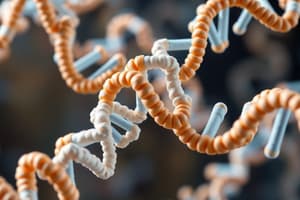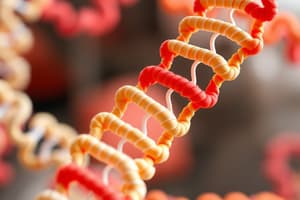Podcast
Questions and Answers
What is the first step in the initiation of protein synthesis in prokaryotes?
What is the first step in the initiation of protein synthesis in prokaryotes?
- Formation of the Shine-Dalgarno sequence
- Binding of the large ribosomal subunit
- Binding of the small ribosomal subunit to the initiation codon (correct)
- Interaction of amino acids with ribosomal RNA
What is the role of initiation factors in the initiation of translation?
What is the role of initiation factors in the initiation of translation?
- To provide energy for peptide bond formation
- To stabilize mRNA during translation
- To facilitate termination of protein synthesis
- To assist the binding of ribosomal subunits to mRNA (correct)
Which component interacts with the Shine-Dalgarno sequence to position the ribosomal subunit?
Which component interacts with the Shine-Dalgarno sequence to position the ribosomal subunit?
- mRNA
- 16S ribosomal RNA (correct)
- Amino acids
- tRNA
What is the function of IF1 in bacterial protein synthesis initiation?
What is the function of IF1 in bacterial protein synthesis initiation?
What is the significance of the AUG sequence during initiation of translation?
What is the significance of the AUG sequence during initiation of translation?
What type of protein is IF2 in bacterial cells required for?
What type of protein is IF2 in bacterial cells required for?
Which of the following is NOT a required component for protein synthesis initiation?
Which of the following is NOT a required component for protein synthesis initiation?
What characterizes the ribosomal involvement in the initiation step of protein synthesis?
What characterizes the ribosomal involvement in the initiation step of protein synthesis?
What role does IF3 play in the initiation of protein synthesis in bacteria?
What role does IF3 play in the initiation of protein synthesis in bacteria?
Which amino acid is always the first to be incorporated during the initiation of protein synthesis?
Which amino acid is always the first to be incorporated during the initiation of protein synthesis?
What is the primary function of the initiator aa-tRNA in the ribosome?
What is the primary function of the initiator aa-tRNA in the ribosome?
Which initiation factor positions the initiator aa-tRNA within the ribosome?
Which initiation factor positions the initiator aa-tRNA within the ribosome?
What defines the AUG codon in eukaryotic translation initiation?
What defines the AUG codon in eukaryotic translation initiation?
During the initiation phase in eukaryotic cells, which event occurs after the 43S preinitiation complex scans for the AUG codon?
During the initiation phase in eukaryotic cells, which event occurs after the 43S preinitiation complex scans for the AUG codon?
Which ribosomal subunit joins the complex after the initiation steps in eukaryotic translation?
Which ribosomal subunit joins the complex after the initiation steps in eukaryotic translation?
What drives the mechanical changes in ribosomes during translation?
What drives the mechanical changes in ribosomes during translation?
Flashcards are hidden until you start studying
Study Notes
Protein Synthesis Overview
- Protein synthesis (translation) is a complex cellular process requiring tRNAs, ribosomes, mRNA, various proteins, cations, and GTP.
- Involves 20 different amino acids arranged in a precise sequence dictated by a coded message.
- Translation is similar in prokaryotes and eukaryotes and consists of three main stages: Initiation, Elongation, and Termination.
Initiation in Prokaryotes
-
Step 1: Binding of Small Ribosomal Subunit
- The small ribosomal subunit binds to the AUG initiation codon in mRNA.
- Bacterial mRNAs feature a Shine-Dalgarno sequence that pairs with 16S rRNA, positioning the 30S subunit at the initiation codon.
-
Initiation Factors in Bacteria
- Essential factors: IF1, IF2, and IF3 assist in initiation.
- IF1 stabilizes the 30S-rRNA complex and prevents incorrect tRNA entry.
- IF2, a GTP-binding protein, facilitates the attachment of the first aminoacyl-tRNA.
- IF3 prevents premature joining of the large 50S subunit and helps position the initiator tRNA.
-
Step 2: Bringing First Amino Acid tRNA
- Methionine is always the first amino acid incorporated at the N-terminus of the polypeptide chain.
- Two distinct methionyl-tRNAs exist: one for initiation and one for internal incorporation.
- The initiator tRNA is positioned in the P site of the ribosome, with its anticodon binding to the AUG codon of mRNA.
- Release of IF1 and IF3 follows this step.
Initiation in Eukaryotes
- Requires at least 12 initiation factors composing more than 25 polypeptide chains.
- Formation of the 43S preinitiation complex facilitates interaction with the 5’ mRNA.
- Protein-protein interactions between eIF3 and eIF4G aid in achieving this complex.
- The 43S complex scans the mRNA for the AUG codon in the context of the Kozak sequence, typically 5' CCACCAUGC 3'.
- Upon finding the AUG codon, eIF2-GTP is hydrolyzed, leading to the release of eIF2-GDP and associated eIFs, allowing the 60S subunit to join, completing initiation.
Additional Key Points
- Ribosomes engage in repetitive cycles of mechanical changes, powered by GTP hydrolysis.
- Information in the mRNA dictates the sequence of aminoacyl-tRNAs accepted during translation.
- Ribosomal RNAs are crucial in selecting tRNAs and ensuring proper translation fidelity.
Studying That Suits You
Use AI to generate personalized quizzes and flashcards to suit your learning preferences.




